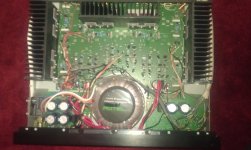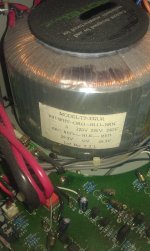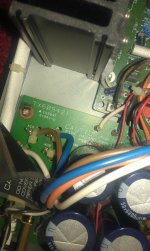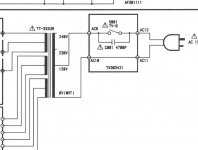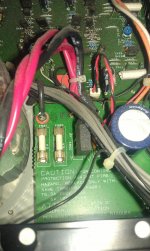I have a 120V ROTEL RB-976 that I need to convert to 240V.
The manual states:
"Should you move your RB-976 amplifier to another country,
it is possible to reconfigure your amplifier for use on a differentline voltage"
Which sounds like there may be a jumper in the unit to reconfigure it.
I had a look inside and see the transformer has 120V, 230V and 240V wires all connected to the board (see photos). However I cant find any jumpers.
Can anyone shed some light on this?
Thanks
The manual states:
"Should you move your RB-976 amplifier to another country,
it is possible to reconfigure your amplifier for use on a differentline voltage"
Which sounds like there may be a jumper in the unit to reconfigure it.
I had a look inside and see the transformer has 120V, 230V and 240V wires all connected to the board (see photos). However I cant find any jumpers.
Can anyone shed some light on this?
Thanks
Attachments
Do the orange, blue and brown wires all say AC0 next to them? The photo is small and the legend for the blue wire is hidden from view.
It would appear that you need to desolder the orange wire and brown wire and swap them round, but I would have thought the orange wire would have a legend other than AC0 if that was right.
It would appear that you need to desolder the orange wire and brown wire and swap them round, but I would have thought the orange wire would have a legend other than AC0 if that was right.
Last edited:
Thanks, that makes sense.
Each wire has a different number - AC8 for the orange and AC9 for the brown etc
Is it possible that the amp can automatically detect input voltage, and that is why all the wires are already soldered to the board?
I suppose I will have to replace the fuses as well, to 240V spec.?
cheers
Each wire has a different number - AC8 for the orange and AC9 for the brown etc
Is it possible that the amp can automatically detect input voltage, and that is why all the wires are already soldered to the board?
I suppose I will have to replace the fuses as well, to 240V spec.?
cheers
It definitely won't automatically change from one voltage to another. Fuses are general around half the current rating when going from 120 to 240 volts.
You need to be sure... if there is ANY doubt then make a note of ALL the secondary's and then isolate them ALL. Fit a low wattage "bulb tester" to the primary and then when you have altered the primary as you think fit power the transformer up and check the voltages are as expected. Any mistakes will just light the bulb and cause no damage.
You need to be sure... if there is ANY doubt then make a note of ALL the secondary's and then isolate them ALL. Fit a low wattage "bulb tester" to the primary and then when you have altered the primary as you think fit power the transformer up and check the voltages are as expected. Any mistakes will just light the bulb and cause no damage.
could you clarify isolating the primary and secondary of the transformer? I'm keen to learn this but don't understand all the practicalities as yet. Thanks
ps what's the worst that could happen if I swap the Orange and Brown and just plug it in? I thought the fuses would protect the amp?
ps what's the worst that could happen if I swap the Orange and Brown and just plug it in? I thought the fuses would protect the amp?
Just checked, the board label near the fuse and it specifies the current rating for a 240v as 3A, half the 120v rating as you said.
Last edited:
The primary windings are all the connections on the MAINS side of things. The secondary connections are the low voltage winding that power the amplifier.
Do you have service manual or circuit for this amp ? If you can come up with one then that might make it clearer.
Do you have service manual or circuit for this amp ? If you can come up with one then that might make it clearer.
Look at this closely which shows your amp. You keep "AC10" where it is. You move AC8 to the top winding.
TURN THE AMP OFF AND UNPLUG FROM MAINS.
If you connect your meter (on low ohms range) to AC10 and measure the resistance to each of the other windings you will see the resistance gets higher and higher. For example it might read 5 ohms as drawn, 6 ohms as you measure to the next winding up, and 8 ohms as you measure to the top winding.
The 240 volt setting is the HIGHEST resistance setting. In other words all the windings together.
TURN THE AMP OFF AND UNPLUG FROM MAINS.
If you connect your meter (on low ohms range) to AC10 and measure the resistance to each of the other windings you will see the resistance gets higher and higher. For example it might read 5 ohms as drawn, 6 ohms as you measure to the next winding up, and 8 ohms as you measure to the top winding.
The 240 volt setting is the HIGHEST resistance setting. In other words all the windings together.
Attachments
Thanks Mooly, nicely explained.
It measured as you said, with the 240v Brown wire showing the highest resistance on the meter.
So now I can safely do the swap?
I'll still need to replace the fuses and connect a new plug of of course.
cheers
It measured as you said, with the 240v Brown wire showing the highest resistance on the meter.
So now I can safely do the swap?
I'll still need to replace the fuses and connect a new plug of of course.
cheers
swap
If you look at page 4 of the RB976 service manual, bottom, you'll see that point AC8 is connected to the switch (S0001) through a copper trace, and AC7 + AC9 are dummy solder pins.
ok so I had closer look at the fuses at the front the unit. I am a bit confused by the note that appears to say that a 240v fuse should be a T6.3A? Pic below.
According to the note at the rear of the unit, the fuses appear to be the same current rating as the 120v but with a "T" in front off the current rating. ie T5A vs 5A (pic below . It is difficult to see as they have covered the text with a black marker). Does that mean the only difference between the fuses is that the 240v is a slow blow fuse?
According to the note at the rear of the unit, the fuses appear to be the same current rating as the 120v but with a "T" in front off the current rating. ie T5A vs 5A (pic below . It is difficult to see as they have covered the text with a black marker). Does that mean the only difference between the fuses is that the 240v is a slow blow fuse?
Attachments
Last edited:
As before - 120V models use mains fuses with 6 amp rating, 240(230)V models use 3 amp fuses.
T6 is the outline or dimensions of the fuse, like 3AG, meaning 6.3 mm dia x 31.7 mm long.
Don't confuse the ratings with specs which unfortunately, look to mean the same thing - they don't.
I think the glass fuse you are showing is associated with an amplifier module and so,
wouldn't change with supply voltage.
AH suffix means ceramic body, slow-blow. AL means glass body slow-blow.
In neither case can you just fit plain wire, fast-blow fuses.
The original types should be used to ensure the same protection reliability, since there are many types of slow-blow or delayed action fuses but it's not always possible to buy what you need conveniently or cheaply in small quantity. I would ask your local service tech. if he wouldn't mind showing what he has available and for sale. They don't like DIYs of course, but you can always ask.
T6 is the outline or dimensions of the fuse, like 3AG, meaning 6.3 mm dia x 31.7 mm long.
Don't confuse the ratings with specs which unfortunately, look to mean the same thing - they don't.
I think the glass fuse you are showing is associated with an amplifier module and so,
wouldn't change with supply voltage.
AH suffix means ceramic body, slow-blow. AL means glass body slow-blow.
In neither case can you just fit plain wire, fast-blow fuses.
The original types should be used to ensure the same protection reliability, since there are many types of slow-blow or delayed action fuses but it's not always possible to buy what you need conveniently or cheaply in small quantity. I would ask your local service tech. if he wouldn't mind showing what he has available and for sale. They don't like DIYs of course, but you can always ask.
Last edited:
As before - 120V models use 6 amp rating, 240(230)V models use 3 amp fuses.
Thanks for confirming - the "T6" confused me.
Now I still don't understand why the rear fuses are the same current rating for 120v and 240v. Here is the note on the board above the rear fuses if you cant see it clearly in the second photo:
"5A 125V
T5A 250V"
Is the 5A and T5A again a spec rather than a rating?
Last edited:
I think the glass fuse you are showing is associated with an amplifier module and so, wouldn't change with supply voltage.
You must have edited your post after I posted.
So I don't need to change the rear fuses?
Cheers
The T stands for Träge, is German for slow.
So they are both 5 amp fuses but the 250v fuse is a slow blow and the 125v is not?
This is quite confusing
hmm. an error there, sorry and the timeout beat me.
T is the fuse type, the number is the rating as you guessed. They usually come in 3AG (6,3 dia, x 31.7mm) or M205 (5 x 20 mm) sizes. The issue with the fuse you show in the second pic. is that it's for one of the power amplifiers and these don't change with the mains, only with the individual amplifier power rating and the there are 2 sizes of amps in the Rotel, so 2 fuse ratings.
A voltage rating on a fuse can mean nothing other than a safety rating limit like saying a resistor is safe for use in applications up to so many volts. A standard fuse type is usually rated 250V here but may be different elsewhere. It is probably unnecessary to use a 250V rating with the smaller amplifier.
T is the fuse type, the number is the rating as you guessed. They usually come in 3AG (6,3 dia, x 31.7mm) or M205 (5 x 20 mm) sizes. The issue with the fuse you show in the second pic. is that it's for one of the power amplifiers and these don't change with the mains, only with the individual amplifier power rating and the there are 2 sizes of amps in the Rotel, so 2 fuse ratings.
A voltage rating on a fuse can mean nothing other than a safety rating limit like saying a resistor is safe for use in applications up to so many volts. A standard fuse type is usually rated 250V here but may be different elsewhere. It is probably unnecessary to use a 250V rating with the smaller amplifier.
Last edited:
So to summarise my (mis)understanding of the fuses required for 240v operation:
Fuses at the front noted as "T6.3A" =
6.3 amp slow-blow (T) ceramic fuse
OR
is it [T6] 3 amp slow-blow ceramic fuse?
Fuses at the back noted as "T5A" = 5 amp slow blow (T) glass fuse.
Fuses at the front noted as "T6.3A" =
6.3 amp slow-blow (T) ceramic fuse
OR
is it [T6] 3 amp slow-blow ceramic fuse?
Fuses at the back noted as "T5A" = 5 amp slow blow (T) glass fuse.
I just checked the parts list in the service manual and it confirms that it is a "T6.3A S" fuse for the front section of the unit.
Now what does the "S" stand for?
From another site: "... If the ferrules of the fuse are silver-plated, the current rating will be followed by the letter "S.""
How important is it that the replacement fuse ferrules are silver plated?
Now what does the "S" stand for?
From another site: "... If the ferrules of the fuse are silver-plated, the current rating will be followed by the letter "S.""
How important is it that the replacement fuse ferrules are silver plated?
- Status
- Not open for further replies.
- Home
- Amplifiers
- Solid State
- Help with Rotel voltage reconfiguration
